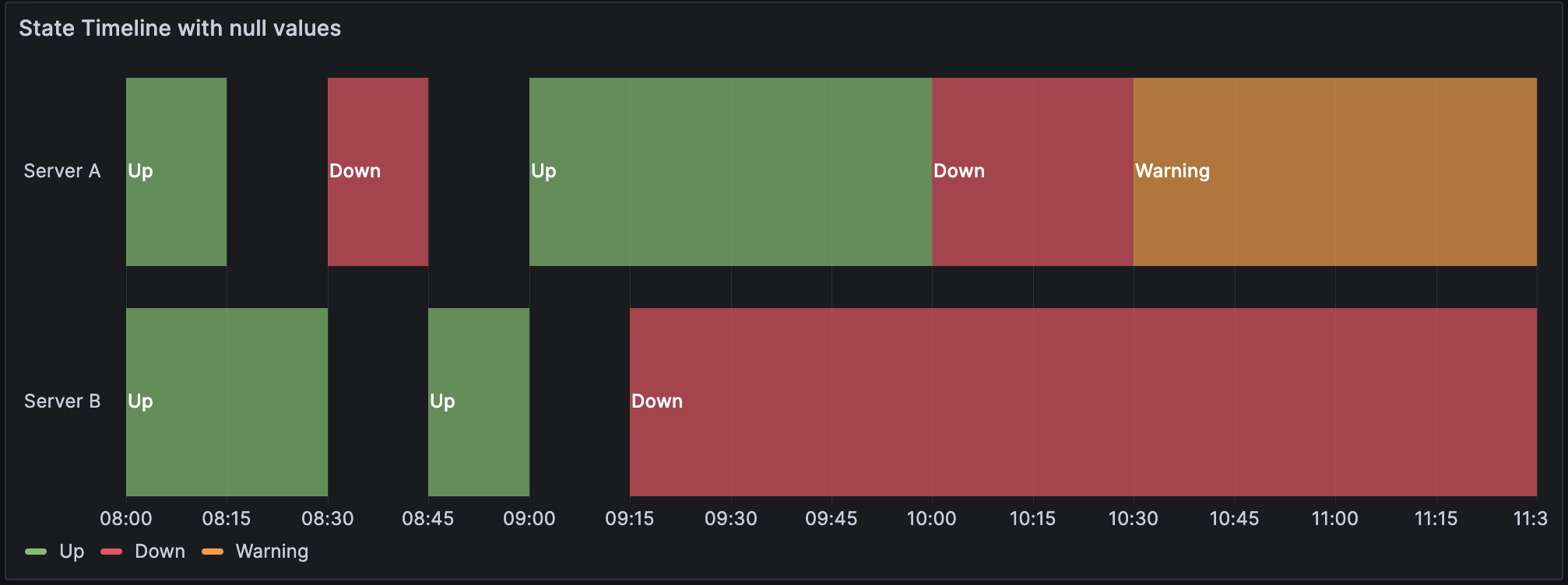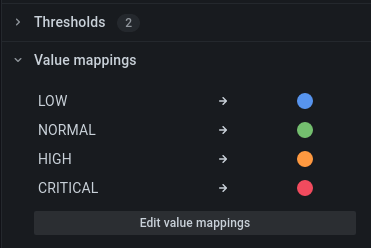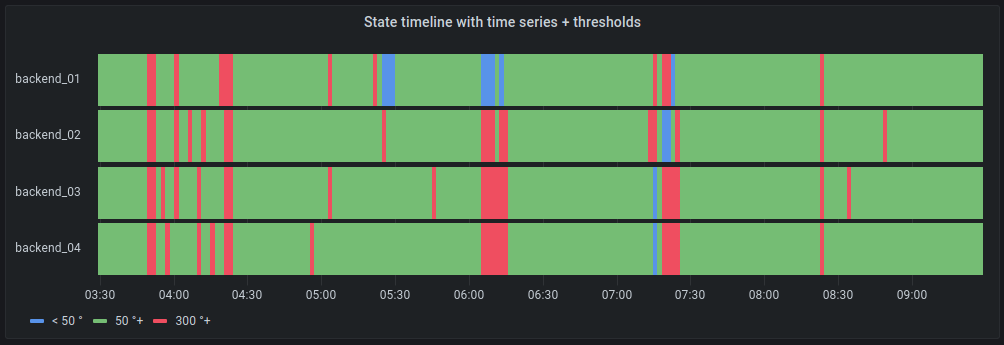Important: This documentation is about an older version. It's relevant only to the release noted, many of the features and functions have been updated or replaced. Please view the current version.
State timeline
A state timeline visualization displays data in a way that shows state changes over time. In a state timeline, the data is presented as a series of bars or bands called state regions. State regions can be rendered with or without values, and the region length indicates the duration or frequency of a state within a given time range.
For example, if you’re monitoring the CPU usage of a server, you can use a state timeline to visualize the different states, such as “LOW,” “NORMAL,” “HIGH,” or “CRITICAL,” over time. Each state is represented by a different color and the lengths represent the duration of time that the server remained in that state:

The state timeline visualization is useful when you need to monitor and analyze changes in states or statuses of various entities over time. You can use one when you need to:
- Monitor the status of a server, application, or service to know when your infrastructure is experiencing issues over time.
- Identify operational trends over time.
- Spot any recurring issues with the health of your applications.
Configure a state timeline
With Grafana Play, you can explore and see how it works, learning from practical examples to accelerate your development. This feature can be seen on Grafana State Timeline & Status History.
Supported data formats
The state timeline visualization works best if you have data capturing the various states of entities over time, formatted as a table. The data must include:
- Timestamps - Indicate when each state change occurred. This could also be the start time for the state change. You can also add an optional timestamp to indicate the end time for the state change.
- Entity name/identifier - Represents the name of the entity you’re trying to monitor.
- State value - Represents the state value of the entity you’re monitoring. These can be string, numerical, or boolean states.
Each state ends when the next state begins or when there is a null value.
Examples
The following tables are examples of the type of data you need for a state timeline visualization and how it should be formatted.
Single time column with null values
| Timestamps | Server A | Server B |
|---|---|---|
| 2024-02-29 8:00:00 | Up | Up |
| 2024-02-29 8:15:00 | null | Up |
| 2024-02-29 8:30:00 | Down | null |
| 2024-02-29 8:45:00 | Up | |
| 2024-02-29 9:00:00 | Up | |
| 2024-02-29 9:15:00 | Up | Down |
| 2024-02-29 9:30:00 | Up | Down |
| 2024-02-29 10:00:00 | Down | Down |
| 2024-02-29 10:30:00 | Warning | Down |
The data is converted as follows, with the null and empty values visualized as gaps in the state timeline:

Two time columns without null values
| Start time | End time | Server A | Server B |
|---|---|---|---|
| 2024-02-29 8:00:00 | 2024-02-29 8:15:00 | Up | Up |
| 2024-02-29 8:15:00 | 2024-02-29 8:30:00 | Up | Up |
| 2024-02-29 8:45:00 | 2024-02-29 9:00:00 | Down | Up |
| 2024-02-29 9:00:00 | 2024-02-29 9:15:00 | Down | Up |
| 2024-02-29 9:30:00 | 2024-02-29 10:00:00 | Down | Down |
| 2024-02-29 10:00:00 | 2024-02-29 10:30:00 | Warning | Down |
The data is converted as follows:

If your query results aren’t in a table format like the preceding examples, especially for time-series data, you can apply specific transformations to achieve this.
State timeline options
Use these options to refine the visualization.
Merge equal consecutive values
Controls whether Grafana merges identical values if they are next to each other.
Show values
Controls whether values are rendered inside the state regions. Auto will render values if there is sufficient space.
Align values
Controls value alignment inside state regions.
Row height
Controls how much space between rows there are. 1 = no space = 0.5 = 50% space.
Line width
Controls line width of state regions.
Fill opacity
Controls the opacity of state regions.
Connect null values
Choose how null values, which are gaps in the data, appear on the graph. Null values can be connected to form a continuous line or set to a threshold above which gaps in the data are no longer connected.

- Never: Time series data points with gaps in the data are never connected.
- Always: Time series data points with gaps in the data are always connected.
- Threshold: Specify a threshold above which gaps in the data are no longer connected. This can be useful when the connected gaps in the data are of a known size and/or within a known range, and gaps outside this range should no longer be connected.
Disconnect values
Choose whether to set a threshold above which values in the data should be disconnected.

- Never: Time series data points in the data are never disconnected.
- Threshold: Specify a threshold above which values in the data are disconnected. This can be useful when desired values in the data are of a known size and/or within a known range, and values outside this range should no longer be connected.
Value mappings
To assign colors to boolean or string values, you can use Value mappings.

Time series data with thresholds
The visualization can be used with time series data as well. In this case, the thresholds are used to turn the time series into discrete colored state regions.

Legend options
When the legend option is enabled it can show either the value mappings or the threshold brackets. To show the value mappings in the legend, it’s important that the Color scheme as referenced in Color scheme is set to Single color or Classic palette. To see the threshold brackets in the legend set the Color scheme to From thresholds.
Legend mode
Use these settings to define how the legend appears in your visualization. For more information about the legend, refer to Configure a legend.
- List - Displays the legend as a list. This is a default display mode of the legend.
- Table - Displays the legend as a table.
- Hidden - Hides the legend.
Legend placement
Choose where to display the legend.
- Bottom - Below the graph.
- Right - To the right of the graph.
Legend values
Choose which of the standard calculations to show in the legend. You can have more than one.



